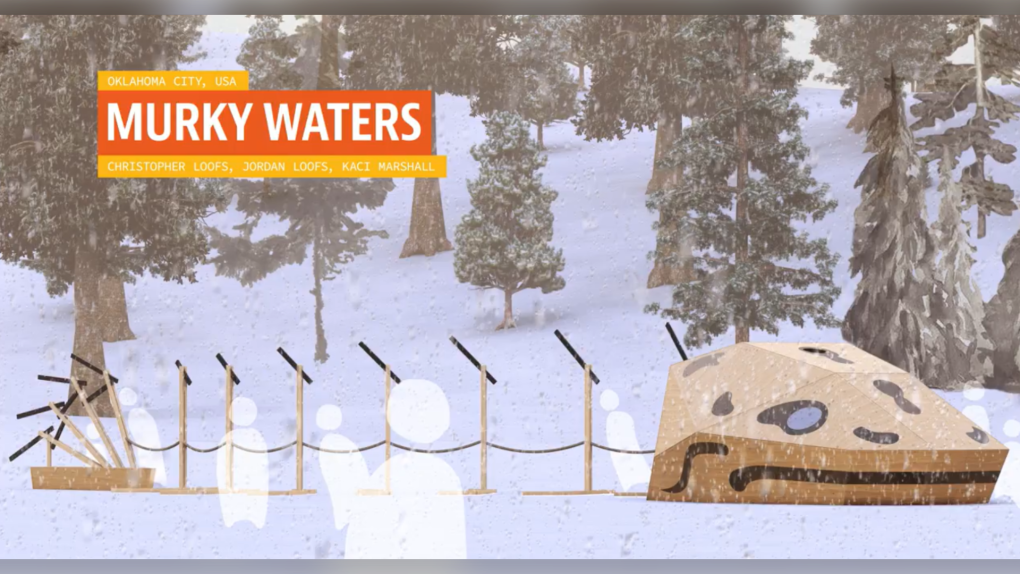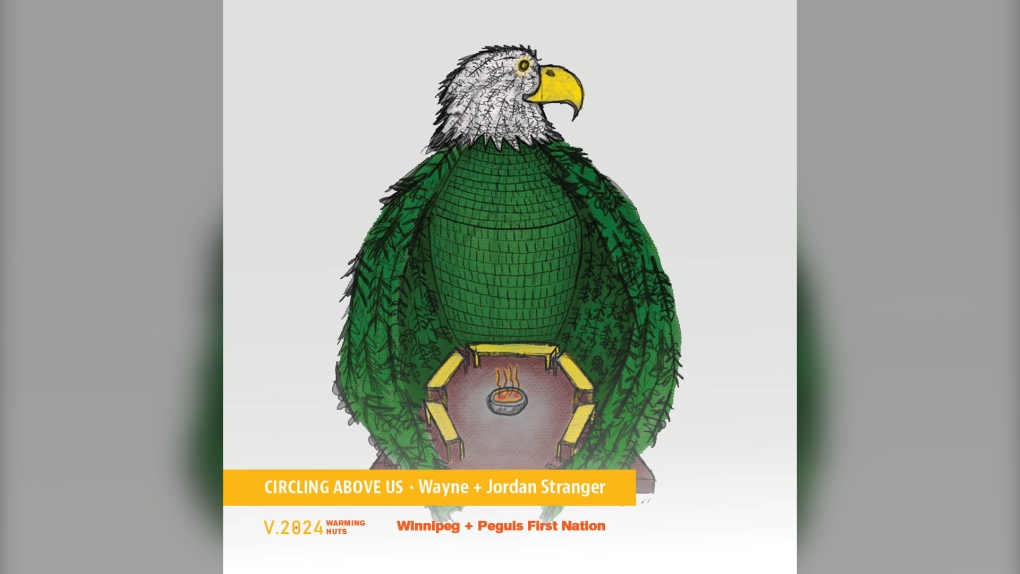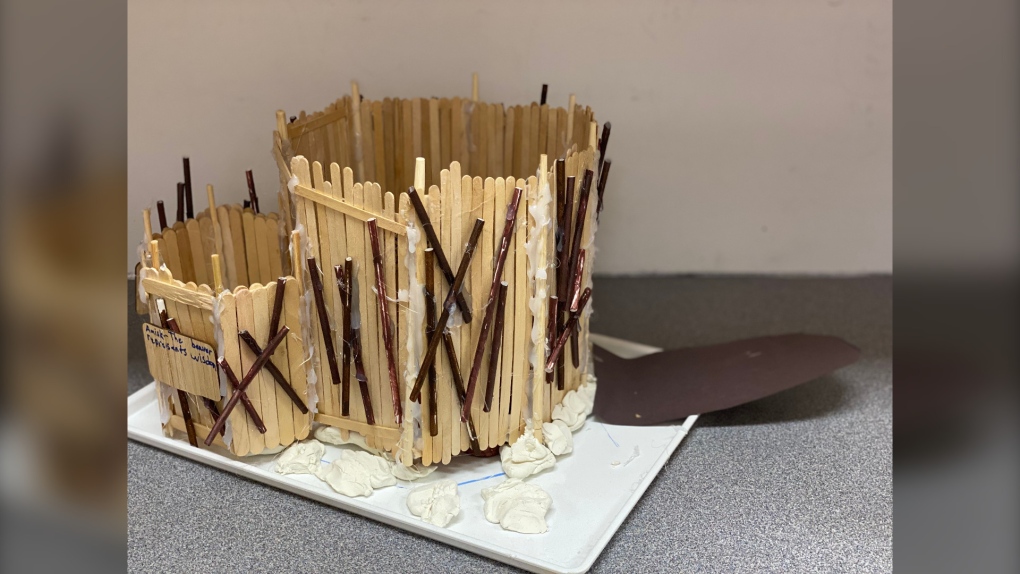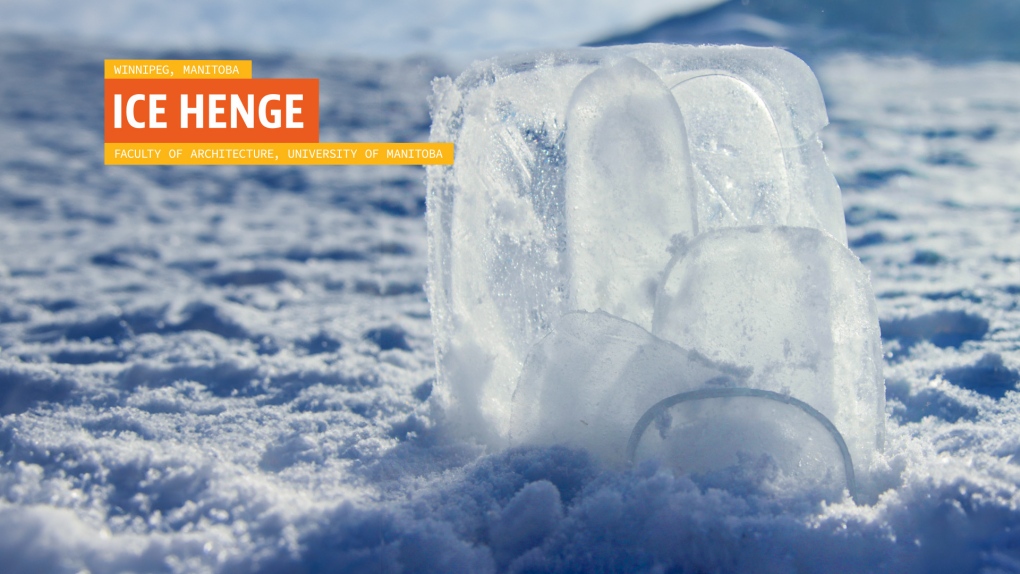Taking a look at the new Warming Hut winners
An eagle, a salute to dim sum and a wintery take on Stonehenge are just some of the new warming huts set to adorn The Forks’ Nestaweya River Trail in the new year.
The structures were selected as part of The Warming Huts v.2024 Architecture Competition.
Started in 2009, the contest puts out a global call for unique and mind-bending designs where visitors to the river trail can warm up and marvel at creativity and architecture.
“These huts are designed and built by people for people. They're plunked down on the river to be explored, admired and enjoyed by anyone and everyone,” said Sara Stasiuk, CEO of The Forks North Portage at a news conference Thursday.
This year’s competition had over 200 submissions from around the world, judged anonymously by a jury.
 The winning entry "Murky Waters" by Christopher Loofs, Jordan Loofs, and Kaci Marshall is shown in a design rendering image. (Source: The Forks)
The winning entry "Murky Waters" by Christopher Loofs, Jordan Loofs, and Kaci Marshall is shown in a design rendering image. (Source: The Forks)
The winning submissions this year are “Murky Waters” designed by Oklahoma City’s Christopher Loofs, Jordan Loofs, and Kaci Marshall, “Spinning Dim Sum” by Verena Nelles Kempf from Switzerland and Ilga Nelles of Germany, and “Sublimation,” which was designed by Francisco Silva and Barbara Stallone from France and Alexander Pollard from England.
“This year’s new hut designs are again unique, very diverse. Each hut has its own meaning and tells its own story.”
 "Sublimation" is designed as a pavilion forming a beacon in nature, embodying "an intrinsic, distilled beauty." (Source: The Forks)
"Sublimation" is designed as a pavilion forming a beacon in nature, embodying "an intrinsic, distilled beauty." (Source: The Forks)
Joining the pack is a team of invited artists featuring Wayne and Jordan Stranger, a father and son duo from Peguis First Nation.
Their design titled “Circling Above Us” is inspired by an eagle which holds special meaning for the Stranger family.
“They’ve always shown up in times of need, in times of pure joy, times of change. With this warming hut, that’s exactly what eagles bring – love and warmth,” said Jordan Stranger.
“The idea is to have that eagle wrapped around the people that enter, and have that fire pit to keep them warm.”
 "Circling Above Us" was designed by father and son team Wayne and Jordan Stranger. The eagle is meant to create a safe space with good energy, serving as a reminder of the effect of the environment. (Source: The Forks)
"Circling Above Us" was designed by father and son team Wayne and Jordan Stranger. The eagle is meant to create a safe space with good energy, serving as a reminder of the effect of the environment. (Source: The Forks)
A submission by the next generation of potential artists will also take shape on the river trail. École St. Avila School’s submission “Amisk” is this year’s winner of the school program, which will be made from materials found in nature, and invites users to learn about Turtle Island and the importance of the beaver.
“We want the project to be accessible to all ages, and we are looking to create a hut where families can enter, warm up, and self-educate," said École St. Avila School teacher librarian Tytanya Fillion, who lead the project.
"When it was announced that Amisk was chosen, everyone cheered, and from that day we’ve all been a part of team Amisk.”
 École St. Avila School's submission "Amisk" is shown in a model created by students. (Source: The Forks)
École St. Avila School's submission "Amisk" is shown in a model created by students. (Source: The Forks)
Rounding out the group – the University of Manitoba’s Faculty of Architecture’s design titled “Ice Henge,” billed as a snowy take on Stonehenge.
“In a world hurtling towards hyper-connectivity and simultaneous disingenuity, we seek to counter this trend by creating an intervention that combines warmth, and joy in a juxtaposition of the ice and landscape,” said team member Kyra Kwiatkowski .
Build week for the six new huts will happen at the end of January, with winning teams converging in Winnipeg to bring their designs to life.
The huts will be placed on both the Nestaweya River Trail and in the Arctic Glacier Winter Park, along with returning huts from past years.
 The University of Manitoba's Faculty of Architecture's submission "Ice Henge" seeks to enhance the existing ice and snow environment. (Source: The Forks)
The University of Manitoba's Faculty of Architecture's submission "Ice Henge" seeks to enhance the existing ice and snow environment. (Source: The Forks)
CTVNews.ca Top Stories

'Mayday! Mayday! Mayday!': Details emerge in Boeing 737 incident at Montreal airport
New details suggest that there were communication issues between the pilots of a charter flight and the control tower at Montreal's Mirabel airport when a Boeing 737 made an emergency landing on Wednesday.
Trudeau appears unwilling to expand proposed rebate, despite pressure to include seniors
Prime Minister Justin Trudeau does not appear willing to budge on his plan to send a $250 rebate to 'hardworking Canadians,' despite pressure from the opposition to give the money to seniors and people who are not able to work.
Hit man offered $100,000 to kill Montreal crime reporter covering his trial
Political leaders and press freedom groups on Friday were left shell-shocked after Montreal news outlet La Presse revealed that a hit man had offered $100,000 to have one of its crime reporters assassinated.
Cucumbers sold in Ontario, other provinces recalled over possible salmonella contamination
A U.S. company is recalling cucumbers sold in Ontario and other Canadian provinces due to possible salmonella contamination.
Trudeau says no question incoming U.S. president Trump is serious on tariff threat
Prime Minister Justin Trudeau says incoming U.S. president Donald Trump's threats on tariffs should be taken seriously.
In a shock offensive, insurgents breach Syria's largest city for the first time since 2016
Insurgents breached Syria's largest city Friday and clashed with government forces for the first time since 2016, according to a war monitor and fighters, in a surprise attack that sent residents fleeing and added fresh uncertainty to a region reeling from multiple wars.
Canada Bread owner sues Maple Leaf over alleged bread price-fixing
Canada Bread owner Grupo Bimbo is suing Maple Leaf Foods for more than $2 billion, saying it lied about the company's involvement in an alleged bread price-fixing conspiracy.
Musk joins Trump and family for Thanksgiving at Mar-a-Lago
Elon Musk had a seat at the family table for Thanksgiving dinner at Mar-a-Lago, joining President-elect Donald Trump, Melania Trump and their 18-year-old son.
Here's how thick ice needs to be to park a truck on it, according to Sask. Water Security Agency
The Saskatchewan Water Security Agency (WSA) says ice should be at least one foot (30 centimetres) thick before it's safe to drive a car or light truck on a frozen body of water.

































